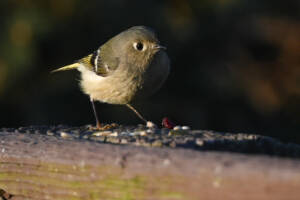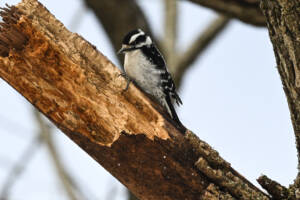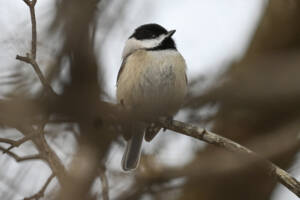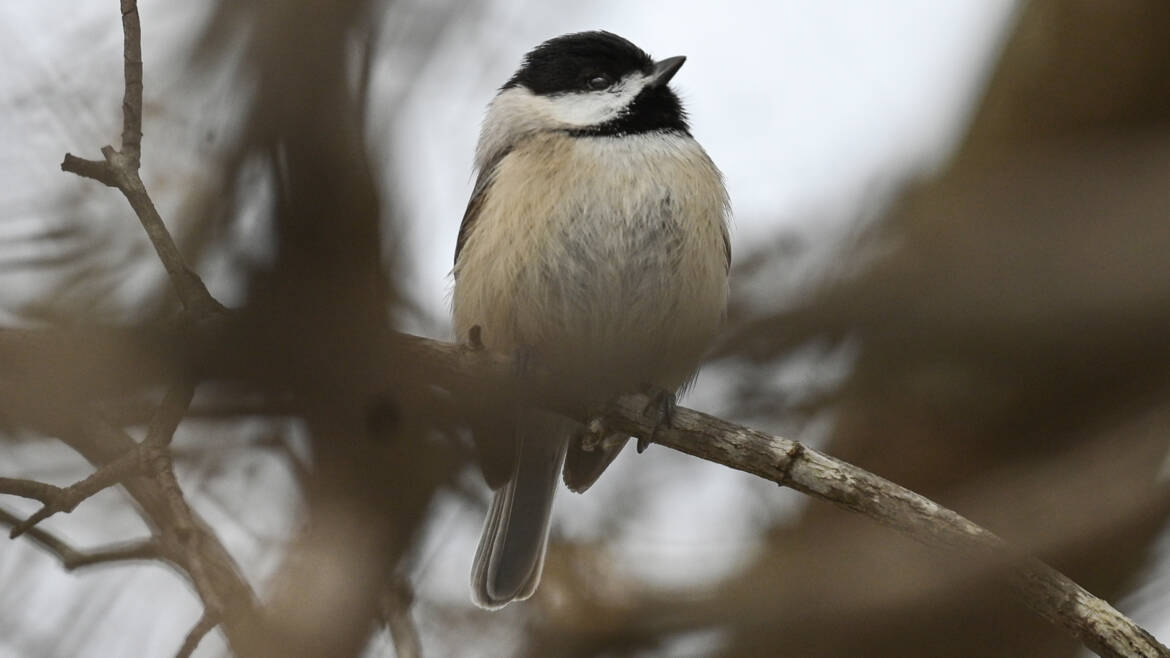GETTING READY FOR A LONG TRIP (photos by Mia Walsh)
 A steady drop in the air pressure was keenly sensed by the mixed flock of chickadees, tufted titmice, a downy woodpecker, and a pair of ruby-crowned kinglets feeding in the understory along Mine Bank Run. The change in pressure forecast a change in weather as a large storm loomed to the south. For the birds this forecast storm is more than an inconvenience, as depending on the storm’s strength and duration, this could be a life and death event. Small songbirds, particularly ones that are migrating are often living on a fine balance between stored fat and available food supply. This balance between life and death can be tipped quickly when poor weather reduces feeding opportunities or requires increased use of fat stores to maintain body temperature.
A steady drop in the air pressure was keenly sensed by the mixed flock of chickadees, tufted titmice, a downy woodpecker, and a pair of ruby-crowned kinglets feeding in the understory along Mine Bank Run. The change in pressure forecast a change in weather as a large storm loomed to the south. For the birds this forecast storm is more than an inconvenience, as depending on the storm’s strength and duration, this could be a life and death event. Small songbirds, particularly ones that are migrating are often living on a fine balance between stored fat and available food supply. This balance between life and death can be tipped quickly when poor weather reduces feeding opportunities or requires increased use of fat stores to maintain body temperature.
Though traveling together in a group, the birds feeding strategies vary slightly. The chickadees and titmice hop through the branches seeking small insects, caterpillars, and spiders while the downy woodpecker pecks at the bark of the trunk and larger branches seeking beetles and grubs living in the softwood. The kinglets alternate between hopping through the foliage and hovering in search of the insects. Through the summer these birds will feed heavily on insects, gaining energy a step or two into the food chain. As winter approaches feeding styles will change and berries and seeds will become part of their diet. The chickadees and titmice will feed heavily on seeds, commonly visiting feeders. The woodpecker will also shift to seeds and berries to supplement its diet. The kinglets are less likely to visit a feeder but will feed on poison ivy berries and other fruit and small seeds from the forest.
In advance of the storm the birds feed heavily on an early fall hatch of insects. The birds chatter quietly among themselves as they feed. The mixed flock provides protection as each bird alternates between feeding and keeping a keen eye out for predators.
themselves as they feed. The mixed flock provides protection as each bird alternates between feeding and keeping a keen eye out for predators.
The coming storm has raised the urgency of their feeding. A cold rainy day or string of days can cause substantial hardship for these birds. The lower air pressure makes flying more strenuous and rain and cooler temperatures reduce insect activity for foraging. Staying dry is critical to their survival, especially as temperatures drop.
The birds feed as the rain begins lightly falling but now, they are distracted by concerns for shelter and survival. The chickadees, titmice and woodpecker are all cavity dwellers that have lived in the forest all summer. They are well aware of shelter opportunities and can retreat to known cavities to stay dry and protected. The kinglets only recently returned to this forest from their breeding grounds and are less familiar with available sheltered spaces. They, not being cavity nesters, are also less inclined to enter a cavity. These birds will seek out the shelter of a clump of leaves, a peeling section of bark, or an overhanging limb.
 The birds snatch up a few more insects and head off to their respective shelters as the rain begins to fall more steadily and the temperatures drop. The chickadees and titmice are quietly tucked into old nesting cavities and, the downy woodpecker moves to the safety of a nearby pileated woodpecker nest. The large cavity provides ample room and a protected view over the valley.
The birds snatch up a few more insects and head off to their respective shelters as the rain begins to fall more steadily and the temperatures drop. The chickadees and titmice are quietly tucked into old nesting cavities and, the downy woodpecker moves to the safety of a nearby pileated woodpecker nest. The large cavity provides ample room and a protected view over the valley.
The kinglets are lucky, finding a broken tree trunk with several crevices large enough for them to perch inside. The two birds huddle together, sharing body heat. To survive the poor weather conditions the birds will reduce their activity. Sitting quietly in sheltered location allows minimal energy use, stretching their fat stores as long as possible. Unfortunately living off their fat stores will only provide a short window of survival. If the poor weather stretches too long, they may be forced to leave their shelter and seek more food.
The rain shower becomes a downpour and stiff winds set the forest canopy swaying. For now, the birds are sheltered and safe, but energy is being used and fat reserves are slowly draining. After a few hours, the storm recedes, and the rain slows. The birds take advantage of the improving weather and head out to the forest searching for stirring insects and early fall fruit and seeds to refuel and prepare for the next survival challenge. The next few months will be an almost daily challenge for survival against rain, cold, snow and wind.
John Canoles
Board Member, Cromwell Valley Park Council
“

